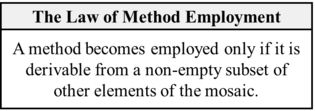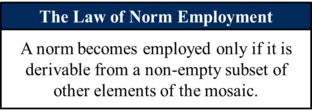The Paradox of Normative Propositions
If methodologies are themselves theories that can be accepted by a community, then how can methods be deductive consequences of accepted theories, given that historically employed methods and accepted methodologies have often been inconsistent with one another?
There are many historical cases where employed scientific methods are known to conflict with professed methodologies. This seems to violate either the third law or the zeroth law of scientific change. By the third law, employed methods are always deductive consequences of accepted theories. But, this seems impossible in cases where accepted methodologies and employed methods conflict. Under the zeroth law, all elements in the scientific mosaic are compatible with one another. But, that seems to be clearly not the case if methodologies and methods conflict with one another. How can this paradox be resolved?
In the scientonomic context, this question was first formulated by Joel Burkholder in 2014. The question is currently accepted as a legitimate topic for discussion by Scientonomy community.
In Scientonomy, the accepted answers to the question can be summarized as follows:
- The new third law resolves the paradox of normative propositions by making it clear that employed methods don't necessarily follow from all accepted theories, but only from some.
- A norm becomes employed only if it is derivable from a non-empty subset of other elements of the mosaic.
- A method becomes employed only if it is derivable from a non-empty subset of other elements of the mosaic.
Contents
Broader History
One species of normative propositions are methodologies, the rules of theory assessment openly prescribed by a scientific community. Methodologies are prescriptive, as they describe how theory assessment within a scientific community ought to be performed. The history of science is filled with cases wherein there is a difference between openly prescribed methodologies and actually employed methods. For example: eighteenth and nineteenth century scientists openly accepted a version of the empiricist inductivist methodology, which required new theories to be deducible from phenomena and not posit any unobservable entities. However, these scientists still accepted theories that posited unobservable entities, such as phlogiston, electric fluid, or absolute space.1pp. 52-53
Scientonomic History
At first, within the scientonomic community, it was unclear whether normative propositions could hold a place within a scientific mosaic—and, therefore, within the scope of a theory of scientific change. This uncertainty also applied to methodological dicta; it was proposed that a full-fledged theory of scientific change, together with history, could attempt to settle the issue.1p. 60 At that time, however, the theory of scientific change did not include normative propositions until the production and acceptance of modifications suggested by Zoe Sebastien - modifications which included changing the definition of theory from, “a set of propositions that attempt to describe something” to “a set of propositions”. This new definition of theory could include normative propositions and, as a result, methodologies. However, regarding this new definition of ‘theory’ as encompassing methodologies, a paradox appears when this definition comes into contact with other components of the theory of scientific change.
Once normative propositions and methodologies began to count as theories, the paradox of normative propositions arose. The problem was that it appeared to violate the third law of scientific change, which stated: a method becomes employed only when it is deducible from other employed methods and accepted theories of the time. If employed methods can must be deducible from other methods or methodologies, differences in methods and methodologies would result in a violation - either methods can follow from methodologies or they can’t. Not only was the third law violated, the incompatibility of the conjuncts of the paradox (that methodologies count as theories; and the third law stating that methods should follow from said methodologies) resulted in the zeroth law’s violation as well. The zeroth law states that at any moment, the theories in a mosaic must be compatible.
Acceptance Record
| Community | Accepted From | Acceptance Indicators | Still Accepted | Accepted Until | Rejection Indicators |
|---|---|---|---|---|---|
| Scientonomy | 1 January 2016 | The question became de facto accepted by the community at that time together with the whole theory of scientific change. | Yes |
All Theories
| Theory | Formulation | Formulated In |
|---|---|---|
| Resolution to the Paradox of Normative Propositions (Sebastien-2016) | The new third law resolves the paradox of normative propositions by making it clear that employed methods don't necessarily follow from all accepted theories, but only from some. | 2016 |
If an answer to this question is missing, please click here to add it.
Accepted Theories
| Community | Theory | Accepted From | Accepted Until |
|---|---|---|---|
| Scientonomy | Resolution to the Paradox of Normative Propositions (Sebastien-2016) | 21 January 2017 |
Suggested Modifications
| Modification | Community | Date Suggested | Summary | Date Assessed | Verdict | Verdict Rationale |
|---|---|---|---|---|---|---|
| Sciento-2016-0001 | Scientonomy | 3 September 2016 | Accept a new formulation of the third law to make it clear that employed methods do not have to be deducible from all accepted theories and employed methods but only from some. | 21 January 2017 | Accepted | There was a community consensus that "the new formulation of the third law does bring an additional level of precision to our understanding of the mechanism of method change".c1 The community agreed that the new formulation "makes a clarification that, on its own, warrants this modification's acceptance".c2 Importantly, it was also agreed that the modification "solves the paradox of normative propositions".c3 |
Current View
The paradox was resolved by Zoe Sebastien in 2016 when she suggested a new formulation of the third law which made it clear that employed methods shouldn't follow from all accepted theories, but only from some.
In Scientonomy, the accepted answers to the question are Resolution to the Paradox of Normative Propositions (Sebastien-2016), The Law of Norm Employment (Rawleigh-2022) and The Law of Method Employment (Rawleigh-2022).
Resolution to the Paradox of Normative Propositions (Sebastien-2016) states: "The new third law resolves the paradox of normative propositions by making it clear that employed methods don't necessarily follow from all accepted theories, but only from some."
The paradox of normative propositions arises from the following three premises:
- there have been many historical cases where employed scientific methods conflicted with professed methodologies;
- by the third law, employed methods are deducible from accepted theories, including methodologies;
- two proposition cannot be mutually inconsistent if one logically follows from another.
Sebastien's solution rejects premise (2), by clarifying that an employed method shouldn't necessarily follow from all accepted theories, but only from some. In those cases, when an employed method is in conflict with an accepted methodology, it is an indication that the former doesn't follow from the latter. As for their mutual inconsistency, that is allowed by the zeroth law.
Mechanism of Method Employment
The Law of Method Employment (Rawleigh-2022) states: "A method becomes employed only if it is derivable from a non-empty subset of other elements of the mosaic."
This law of method employment is a corollary of Rawleigh's law of norm employment. It implies that, just like the norms of all other types, methods become employed when they are derivable from other elements of the agent's mosaic (such as other theories, other methods, and perhaps even questions). As such, the law preserves most of the content of Sebastien's third law by solving some of the issues inherent in it. See The Law of Norm Employment (Rawleigh-2022) for a more thorough exposition.
Mechanism of Norm Employment
The Law of Norm Employment (Rawleigh-2022) states: "A norm becomes employed only if it is derivable from a non-empty subset of other elements of the mosaic."
Sebastien's law of method employment faces several problems. Foremost among these is that it is based on an outdated ontology that assumes that methods of theory evaluation are a fundamental epistemic element. After the acceptance of Barseghyan’s proposal that methods be subsumed under the category of normative theories, the third law no longer exhaustively covers all situations cases of employment. In its present form it is limited to methods, though there is no reason to think that the mechanism by which a method is employed is any different than the mechanism by which any other norm is employed.
In addition, Sebastien's formulation of the third law uses the term deducible, which currently lacks a scientonomic definition. We do not currently know what it means for something to be deducible, what the criteria of deducibility would be, or whether the conditions of deducibility would be part of the first-order theories of the mosaic or part of the second-order theories that range over the mosaic.
The third issue with Sebastien's formulation is that, with the acceptance of questions into the epistemic elements of the ontology of scientific change, the elements of the mosaic are now more expansive than just theories and subtypes of theories. This means that there is a plausible situation in which norms could potentially be derived – at least in part – from questions, which means that a formulation of the third law that excludes questions would fail to comprehensively describe all cases of norm employment.
The new law of norm employment aims to remedy all three of these issues:
- the formulation of the covers all norms rather than only methods;
- it replaces a deducible with derivable, which in the context of mathematical model theory simply means to be semantically entailed, and thus can potentially include non-deductive inferences (e.g. inductive, abductive);
- it replaces a specific enumeration of epistemic elements with a general "elements of the mosaic".
This formulation also offers the slight clarification that derivability strictly deals with derivation from a finite number of other elements.
Related Topics
This question is a subquestion of Mechanism of Method Employment.

